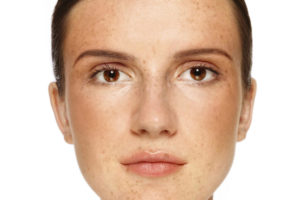Hyperpigmentation
Melasma

Melasma Causes
The cause of melasma is complex. Melasma is a chronic disorder that some believe is linked to genetics. Melasma is more common in women than in men and also in people who tan well or have brown skin. Latin/Hispanic, North African, African-American, Indian, Mediterranean and Middle Eastern people are more likely to get melasma. It occurs when melanocytes (coloring making cells) produce too much color. People with darker skin complexions are more prone to melasma because of their more active melanocytes. Melasma is extremely common in pregnant women that it has been given the name “pregnancy mask”. Usually melasma beings between the ages of 20 and 40. Melasma presents itself as freckle-like spots located on the cheeks, forehead and nose and may eventually appear on other parts of the face and body.
Common melasma triggers include:
- Sun exposure: Exposure to ultraviolet (UV) light deepens the pigmentation because it stimulates melanocytes, the color producing cells of the skin. This is why melasma is worse in the summer. The more sun exposure one has, the greater the chances of developing melasma.
- Hormone changes: Pregnancy may also induce or make melasma worse and cause “pregnancy mask”.
- Birth control pills as well as hormone replacement medications may also trigger melasma.
- Skin Care: Skin care products and cosmetics such as scented soaps, may irritate the skin and make melasma worse.
Melasma Treatments
While there is no cure for melasma, many treatments have been developed. Melasma is known to fade on its own after pregnancy, but many times requires a comprehensive treatment approach by your dermatologist. Melasma can be very slow to respond to treatment, so it is very easy to feel discouraged. General measures for treating melasma include year round sun protection with a high SPF sunscreen applied to the affected areas daily. Sunscreens should be Broad-Spectrum and include active blocking agents such as zinc or titaniuam dioxide. A mild cleanser is recommended twice a day followed by light moisturizer. Bleaching creams such as hydroquinone is a common first line treatment for melasma. It is applied to the skin and to lighten the skin by inhibiting the melanocytes ability to work. Hydroquinone usually comes as a cream and must be applied to the affected areas once or twice a day for at least 4 months. To enhance skin lightening, your dermatologist may prescribe a second medication such as tretinoin or a corticosteroid.
Other topical treatments that may be prescribed are azelaic acid or kojic acid. If topical medicine does not clear your melasma, a few procedures may be recommended in addition.
Chemical peels such as ZO Skin Health’s 3-Step Peel or a series of glycolic acid peels may be used to treat melasma along with laser treatments such as intense pulsed light (IPL). These procedures should be performed by a dermatologist or plastic surgeon because they should be tailored to the patient’s skin type.
Lentigo
Lentigo is a pigmented flat or slightly raised lesion with a clearly defined edge. Lentigo’s do not fade in the winter months. They affect male and females of all ages and races.
Lentigo Causes
Common forms of lentigo are due to exposure to ultraviolet radiation. These types of exposure include sun damage from sunburns, indoor tanning, and phototherapy.
Lentigo Treatments
Most lentigines are left alone but attempts to lighten them may recommended. Your provider may recommend IPL (intense pulsed light) treatments, which is a non-invasive treatment that uses high intensity pulses of light to improve the appearance of lentigines. Hydroquinone bleaching cream is another option when treating lentigo. This bleaching agent is used to lighten a lentigo or lentigines.
To learn more about hyperpigmentation procedures, or to schedule your consultation with Board-Certified Dermatologist Dr. Weyer, please fill out the form on this page. You can call our Tucson location at 520-207-3100 or our Sierra Vista location at 520-458-1787. We look forward to seeing you soon!

